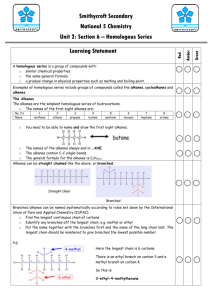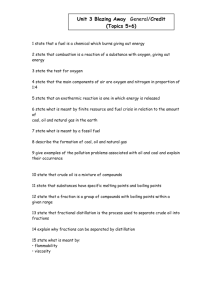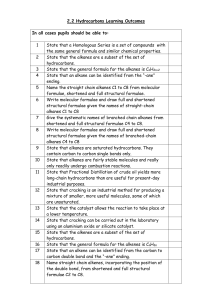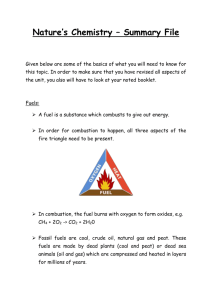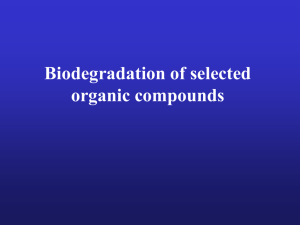Topic 6 – Hydrocarbons – Learning Outcomes
advertisement
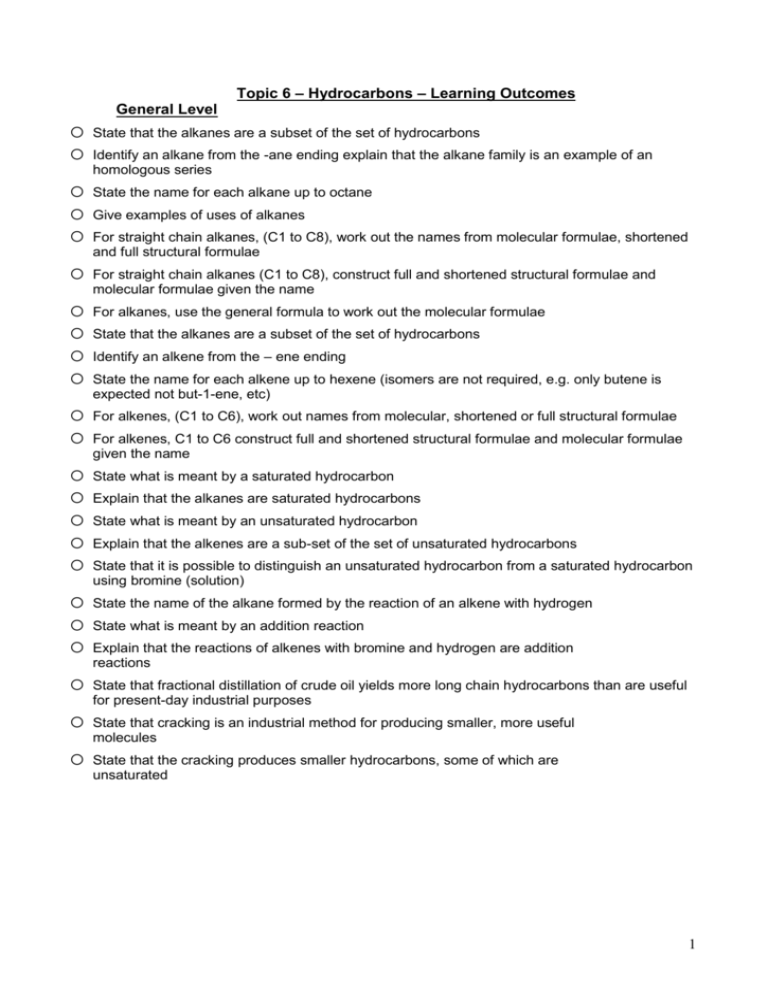
Topic 6 – Hydrocarbons – Learning Outcomes General Level o State that the alkanes are a subset of the set of hydrocarbons o Identify an alkane from the -ane ending explain that the alkane family is an example of an homologous series o State the name for each alkane up to octane o Give examples of uses of alkanes o For straight chain alkanes, (C1 to C8), work out the names from molecular formulae, shortened and full structural formulae o For straight chain alkanes (C1 to C8), construct full and shortened structural formulae and molecular formulae given the name o For alkanes, use the general formula to work out the molecular formulae o State that the alkanes are a subset of the set of hydrocarbons o Identify an alkene from the – ene ending o State the name for each alkene up to hexene (isomers are not required, e.g. only butene is expected not but-1-ene, etc) o For alkenes, (C1 to C6), work out names from molecular, shortened or full structural formulae o For alkenes, C1 to C6 construct full and shortened structural formulae and molecular formulae given the name o State what is meant by a saturated hydrocarbon o Explain that the alkanes are saturated hydrocarbons o State what is meant by an unsaturated hydrocarbon o Explain that the alkenes are a sub-set of the set of unsaturated hydrocarbons o State that it is possible to distinguish an unsaturated hydrocarbon from a saturated hydrocarbon using bromine (solution) o State the name of the alkane formed by the reaction of an alkene with hydrogen o State what is meant by an addition reaction o Explain that the reactions of alkenes with bromine and hydrogen are addition reactions o State that fractional distillation of crude oil yields more long chain hydrocarbons than are useful for present-day industrial purposes o State that cracking is an industrial method for producing smaller, more useful molecules o State that the cracking produces smaller hydrocarbons, some of which are unsaturated 1 Credit Level o State what is meant by an homologous series. o Derive a general formula for alkanes o Explain in terms of increasing molecular size why the boiling point increases as the number of carbon atoms in an alkane increases o State the name of each cycloalkane up to cyclohexane o Explain that the cycloalkane family is an example of an homologous series o State what is meant by isomers o Explain that the alkene family is an example of an homologous series o For alkenes, us a general formula to work out molecular formulae o Derive a general formula for alkenes o Identify from a structural formula the following types of compound: alkanes, cycloalkanes and o alkenes. For simple organic molecules, including alkanes, alkenes and cycloalkanes, construct appropriate isometric forms (isomers), given a molecular formula o State that the catalyst allows the reaction to take place at a lower temperature o Explain why cracking produces a mixture of saturated and unsaturated products. Hydrocarbons In topic we learned that hydrocarbons are compounds made from carbon and hydrogen. There are many types of compounds made from hydrogen and carbon; we need to know about the families called alkanes, alkenes and cycloalkanes. Each family of hydrocarbons is known as a homologous series. A homologous of hydrocarbons can be recognised from the name or from having similar structural properties. Compounds in the same homologous series have the same general formula linking the number of carbons to the number of hydrogen’s. 2 Prefixes All hydrocarbons use prefixes to tell chemists how many carbon atoms they are made from: Prefix Meth Eth Prop But Pent Hex Sept Oct Number of Carbons 1 2 3 4 5 6 7 8 We can use a saying to help us remember the number of carbon atoms with the prefix: “Many elephants prefer buns, poodles have happy owners”. If you ever forget there is a table in the data book that lists the boiling point of alkanes in the correct order. Alkanes Alkanes are homologous series of hydrocarbons. They can be recognised from the –ane ending in their name (e.g. methane, ethane, etc). Alkane molecules all have single carbon-to-carbon bonds and have the same general formula, CnH2n+2. We need to know how to draw full structural formula, shortened structural formula and how to write chemical formula for the first eight alkanes. Complete the table below: 3 Name Full Structural Formula Shortened Formula Chemical Formula Methane CH4 CH4 Ethane CH3CH3 Propane CH3CH2CH3 Butane As we can see going up the hydrocarbon chain, the molecule size very quickly increases. This is matched with an increase in the boiling point. We can see a trend that the larger the size of the molecules the higher the boiling point. Alkanes are said to be saturated molecules as they contain all single bonds, this means there is no space for anything to join on to the molecule. There is a link between the number of carbons and hydrogen’s’ in an alkane molecule. The number of hydrogen’s is double the number of carbons plus 2. We call this the general formula for alkanes and it is written as the following: CnH2n+2 4 Alkenes Alkenes are homologous series of hydrocarbons. They can be recognised from the –ene ending in their name (e.g. ethene, propene, etc). Alkene molecules all have a carbon-to-carbon double bond and have the same general formula, CnH2n. We need to know how to draw full structural formula, shortened structural formula and how to write chemical formula for the first seven alkenes (it is not possible to get methene as this only has one carbon so we can not form a carbon to carbon double bond). Complete the table below: Name Full Structural Formula Ethene Shortened Formula CH2CH2 Propene CH2CHCH3 Chemical Formula Butene There is a link between the number of carbons and hydrogen’s’ in an alkene molecule. The number of hydrogen’s is double the number of carbons. We call this the general formula for alkenes and it is written as the following: CnH2n Alkenes can be identified by reacting them with bromine solution. Bromine solution is brown in colour and when this 5 is reacted with an alkene the brown colour disappears. This is because the bromine can add on across the double bond, it is known as an addition reaction. As alkenes have this double bond they are an unsaturated molecule. This means they have space for things to add on to the molecule. Cycloalkanes Cycloalkanes are homologous series of hydrocarbons. They can be recognised from the cyclo- start in their name (e.g. cyclopropane, cyclobutane, etc). Cycloalkane molecules all have carbon-to-carbon single bonds and have the same general formula, CnH2n. We need to know how to draw full structural formula, shortened structural formula and how to write chemical formula for the first six cycloalkanes (it is not possible to get cyclomethane or cycloethane as we need at least 3 carbons to make a ring). Complete the table below: Name Full Structural Formula Cyclopropane Shortened Formula Chemical Formula Cyclobutane There is a link between the number of carbons and hydrogen’s’ in a cycloalkane molecule. The number of hydrogen’s is double the number of carbons. We call this 6 the general formula for cycloalkanes and it is written as the following: CnH2n Cycloalkanes and alkenes have the same general formula and can be identified by reacting them with bromine solution. Bromine solution is brown in colour and when this is reacted with an alkene the brown colour disappears. In and cycloalkane the brown colour would remain. As cycloalkanes have all single bonds they are known as saturated molecules. Isomers Longer chain hydrocarbons can join together in many different ways, not just in straight lines. Compounds with the same formula but with different structures are called isomers. An example is butane. This can have the following two structures: 7 Cracking In fractional distillation of crude oil we produce lots of long chain hydrocarbons but not enough of the shorter chain hydrocarbons. Fractions like petrol are in high demand but we produce too much bitumen. Chemists can do a cracking reaction that breaks the longer chain hydrocarbons into the smaller hydrocarbons. An example is: C10H22 C4H8 + C6H14 We cannot make any new atoms in this reaction so the total number of hydrogen’s and carbons in the products has to be the same as for the reactants. As we cannot bring any more hydrogen’s into the reaction the products are a mixture of saturated alkanes and unsaturated alkenes. This process happens with a catalyst. This speeds up the reaction but is not used up. Past Paper Questions 07 General: 3, 9 07 Credit: 4, 11 08 General: 4, 10b, 19c, 19d 08 Credit: 3, 19 09 General: 4a, 13, 19, 09 Credit: 5, 19a, 19b, 19d 8

